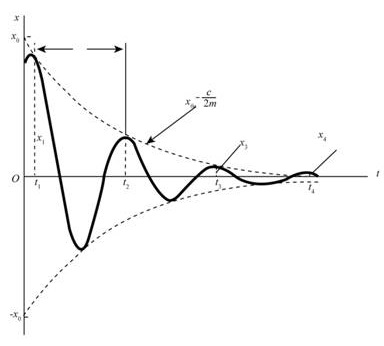
Concept explainers
(a)
The time interval between a maximum positive displacement and the following maximum negative displacement is
Explanation of Solution
Given information:
The system is underdamped, the time period between two successive points is
The figure shows the underdamped system.

Figure-(1)
Write the expression amplitude of vibrations of an underdamped system..
Here, the amplitude of an underdamped system is
Differentiate Equation (I) with respect to time.
For maximum positive and negative displacement,
The maximum negative displacement occurs after a phase difference of
Calculation:
Substitute
Here, the time interval for maximum positive displacement is
Substitute
Here, the time interval for maximum negative displacement is
Substract Equation (V) and (VI).
Substitute
Conclusion:
The time interval between a maximum positive displacement and the following maximum negative displacement is
(b)
The time interval between two successive zero displacement is
Explanation of Solution
Calculation:
Substitute
Substitute
Here, the time interval for first zero displacement is
Substitute
Here, the time interval for second zero displacement is
Substract Equation (X) from (IX).
Substitute
Conclusion:
The time interval between two successive zero displacement is
(c)
The time interval between maximum positive displacement and zero displacement is greater than
Explanation of Solution
Calculation:
Substract Equation (V) from (IX).
The values of
Substitute
Neglect the time interval difference to be negative.
Substitute
Conclusion:
The time interval between maximum positive displacement and zero displacement is greater than
Want to see more full solutions like this?
Chapter 19 Solutions
VECTOR MECH...,DYNAMICS(LOOSE)-W/ACCESS
- determine the allowable bending and contact stresses for a grade 1 steel through-hardened to 250 HB. Assume the desired reliability is 50% and that the pinion and gear have the same hardness and the gear encounters hydrodynamic lubrication and is to last ten million cyclesarrow_forwardUsing the four-point bending tool, detail the influence of both applied load and notch size on the transverse strain. Cover the following points in your answer. a. A detailed description of the methodology you have used to create a set of results suitable to answer this question. Include details on the placement of line scans, the loads used, etc. (there is no need to describe the process of extracting the data from the interactive or the fundamental principles behind DIC). (5 marks) b. A description of the results you have found, including a written description, images, and both vertical and horizontal line scans from the four-point bending tool. Include a minimum of three loads and three notch sizes in your results. (20 marks) c. The conclusions you can make regarding the influence of load and notch size on the strain experienced by the beam based on the data you collect. (5 marks) To achieve full marks, you will need to include the following in your work: • properly labelled graphs…arrow_forwardUsing the four-point bending tool, discuss how measurements of transverse strain using DIC and compare with those from the strain gauge attached at the centre top of the specimen. In your answer, include the following: a. A short explanation of how each of the strain measurement techniques works. (4 marks) b. A description of the methodology you have used to make the data that you discussed from each technique as comparable as possible. (6 marks) c. A set of figures (images, graphs and/or tables as necessary) with appropriate captions demonstrating the comparability of data extracted from the two strain measurement methods. This should include at least three different applied loads. (10 marks) d. A brief description of the findings. (5 marks)arrow_forward
- An undamped single-degree-of-freedom system consists of a spring with stiffness k = 10 kip/in and a mass weighing W = 10 kips. The system is at rest and it is suddenly subjected to a half-cycle sine pulse force. The pulse force has an amplitude po = 1 kips and time duration td = 0.1 seconds. Calculate the maximum restoring force in the spring due to the pulse force.arrow_forwardm=400mm n=300mm q=28mm r=20mm P=0.9kNarrow_forwarddetermine the allowable bending and contact stresses for a Grade 1 steel through-hardened to 250 HB. Assume the desired reliability is 50 %and that the pinion and gear have the same hardness and it is expected that the gear will encounter 100,000 load cyclesarrow_forward
- Please can you plot the Mohr's strain circle using the above informarrow_forwardA gearbox has permanent shaft positions defined by the bearing mounting positions, but the gear ratio can be changed by changing the number of teeth in the pinion and gear. To achieve similar power transmission ability for different gear ratios, a manufacturer chooses to have the same module for two different gearboxes. One of the gaerboxes has a pinion with 22 teeth, a gear with 68 teeth, and a center distance of 225mm. How large is the gear module and which gear ratios are possible for a pinion with 22 or more teeth using the same module?arrow_forwardA gear train has a 50.3 mm circular pitch and a 25 degree pressure angle and meshes with a pinion having 12 teeth Design this gear train to minimize its volume and the total number of teeth. Obtain the pitch diameters the number of teeth the speed ratio the center distance and the module of this gear train. The gearbox housing has a diameter of 620mmarrow_forward
 Elements Of ElectromagneticsMechanical EngineeringISBN:9780190698614Author:Sadiku, Matthew N. O.Publisher:Oxford University Press
Elements Of ElectromagneticsMechanical EngineeringISBN:9780190698614Author:Sadiku, Matthew N. O.Publisher:Oxford University Press Mechanics of Materials (10th Edition)Mechanical EngineeringISBN:9780134319650Author:Russell C. HibbelerPublisher:PEARSON
Mechanics of Materials (10th Edition)Mechanical EngineeringISBN:9780134319650Author:Russell C. HibbelerPublisher:PEARSON Thermodynamics: An Engineering ApproachMechanical EngineeringISBN:9781259822674Author:Yunus A. Cengel Dr., Michael A. BolesPublisher:McGraw-Hill Education
Thermodynamics: An Engineering ApproachMechanical EngineeringISBN:9781259822674Author:Yunus A. Cengel Dr., Michael A. BolesPublisher:McGraw-Hill Education Control Systems EngineeringMechanical EngineeringISBN:9781118170519Author:Norman S. NisePublisher:WILEY
Control Systems EngineeringMechanical EngineeringISBN:9781118170519Author:Norman S. NisePublisher:WILEY Mechanics of Materials (MindTap Course List)Mechanical EngineeringISBN:9781337093347Author:Barry J. Goodno, James M. GerePublisher:Cengage Learning
Mechanics of Materials (MindTap Course List)Mechanical EngineeringISBN:9781337093347Author:Barry J. Goodno, James M. GerePublisher:Cengage Learning Engineering Mechanics: StaticsMechanical EngineeringISBN:9781118807330Author:James L. Meriam, L. G. Kraige, J. N. BoltonPublisher:WILEY
Engineering Mechanics: StaticsMechanical EngineeringISBN:9781118807330Author:James L. Meriam, L. G. Kraige, J. N. BoltonPublisher:WILEY





